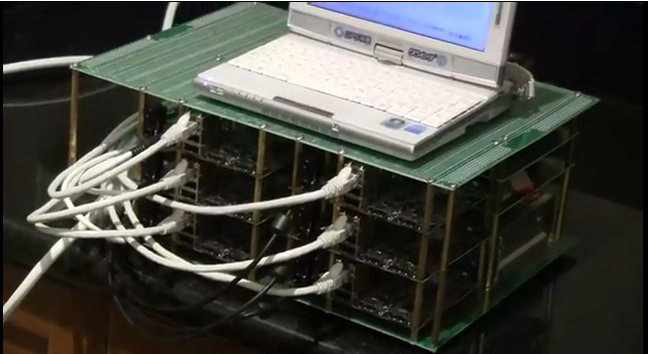Noritsuna Imamura showed an ARM cloud cluster built with 6 Pandaboards at Linaro Connect Q4.11. Noritsuna is a member of the Open Embedded Software Foundation (OESF), a Japanese organization that support Open Source embedded software.

The cluster is made of 6 panda boards with a total 6 GB of RAM (1GB per board) that runs the Google App Engine (http://code.google.com/appengine/) in Ubuntu/Linaro 11.09 release. The middleware used is TyphoonAE, a full-featured and productive serving environment to run Google App Engine (Python) applications. This type of server hosts web applications such as Rietveld (used in the demo below) to be run on (thin) clients. There are also plenty of other software (required by Google App Engine) that runs in this ARM cloud such as MySQL, Apache2, memcached and more.
In the video, a power meter shows that the cluster consumes about 35 W in low activity mode.
Norisuna had a comparison table that showed the Pandaboard cloud (OMAP4 @ 1GHz – 12 Cores) uses 4x times space and 5x less power (50W vs. 257 W) than a Xeon 1.8GHz Quad Core server with about the same amount of processing power and memory (6GB vs. 8GB).
One drawback is that the software is located on the SD Cards of the pandaboards so it can be relatively slow, but this could probably be replaced by SSDs connected via USB without affecting power consumption too much.

The presentation slides are available at http://www.slideshare.net/noritsuna/panda-cloud

Jean-Luc started CNX Software in 2010 as a part-time endeavor, before quitting his job as a software engineering manager, and starting to write daily news, and reviews full time later in 2011.
Support CNX Software! Donate via cryptocurrencies, become a Patron on Patreon, or purchase goods on Amazon or Aliexpress





Hi,
I’ve wrote a blog post about a ARM cluster with Ubuntu, made by Canonical and also made using Pandaboard. Feel free to read it !
http://www.it-wars.com/article263/un-cluster-arm-pour-ubuntu
Regards,
Vincent RABAH
@Vincent RABAH
Hi,
Thanks for the link. Canonical setup looks like a build farm to build natively Ubuntu ARM on 20 pandaboards instead of cross-compiling.
Jean-Luc
@cnxsoft
Yes the purpose of this farm is to build the Ubuntu distro, that take a long time on ARM proc, even if they get more power, more cores 😉
I’m a ARM addicted, and I LOVE your blog 🙂
Regards
Vincent
“…Xeon 1.8GHz Quad Core server with about the same amount of processing power and memory…”
any data to back up that claim? Is that just raw MHz or real benchmarks?
That’s a big assumption from me, no benchmarks here:
Xeon: 4 cores at 1.8 Ghz = 7.2 GHz
6 OMAP4: 12 Cores at 1 Ghz = 12 GHz
I could be wrong here, maybe I should not have written that…
@av500
I went to Coremark website and compared the Coremark 1.0 scores of OMAP4430 running 2 forks and Intel Xeon E5405 (Quad Core @ 2 GHz) running 4 threads.
OMAP 4 gets 5742.20 and Xeon E5405 gets 23579. (See screenshot below)
http://www.cnx-software.com/wp-content/uploads/2011/11/benchmark_coremark_1.0_xeon_e5405_vs_TI_OMAP4430SDP.jpg
But I still think the Xeon server would probably perform (much) better than the pandaboard cluster during “real” tests because of the storage used in the pandaboards (SD Card or external USB storage).
@av500
It really depend on what you need …
– For pure performance -> Xeon
– For scalability, efficiency, no power consumming -> ARM
Using ARM teach me 1 thing : EFFICIENCY ! For example, my blog is self-hosted on an ARMv5 DockStar with USB DD and 128Mb of RAM, I have to optimize image size and compression level, using caching, no database, small php cms engine … To deliver contant even faster than some other web server using Xeon 🙂
On my blog I’ve made some benchmarks, I can serve 2000 unique visitors / 12h !!! And actually I have only about 500 uv/day -> http://www.it-wars.com/article243/performance-de-l-auto-hebergement-avec-le-dockstar My blog post is in French but use the GoogleTranslet widget in the sidebar and feel free to leave comments 😉
Regards,
Vincent
Hi every one,
Can anybody help me setup my cloud with EUCALYPTUS cloud on PANDABOARD.
My project link:
http://sites.google.com/site/witpanda/project-definition/pandacloud
http://pandaboard.org/content/pandacloud-prototype-cloud-computing-platform-panda-board
I have been working for around 6 months, but having problem with eucalyptus-nc and xen installation on pandaboard.
Any help will be appretiated.
Thanks in advance.
PDR Patnaik
@PDR Patnaik
Sorry, I cannot help you since I don’t have Pandaboard hardware.
But I’ll be glad to write about your project in this blog once you have a working demo.